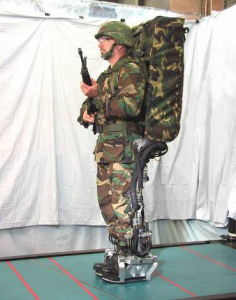How wearable exoskeletons will transform construction site safety
 Wearable exoskeletons have long been the stuff of sci-fi movies, with heroes performing impressive physical feats thanks to the assistive technologies. Sigourney Weaver’s Ripley used an exoskeleton to help defeat a xenomorph queen in the movie Aliens, while Matt Damon wore sported a lightweight suit in his efforts to bring down the corrupt regime in Elysium.
Wearable exoskeletons have long been the stuff of sci-fi movies, with heroes performing impressive physical feats thanks to the assistive technologies. Sigourney Weaver’s Ripley used an exoskeleton to help defeat a xenomorph queen in the movie Aliens, while Matt Damon wore sported a lightweight suit in his efforts to bring down the corrupt regime in Elysium.
But now it seems that wearable exoskeletons have moved from comic book fantasy to workplace reality.
What is a wearable exoskeleton?
More than simply some kind of robotic suit, a wearable exoskeleton actually performs an important task. As the concept develops, scientists have begun to define it as “a wearable, external mechanical structure that enhances the power of a person.”
Although a pallet truck can help to lift and move heavy items, it is not wearable – so it doesn’t count as an exoskeleton.
The system must give the wearer some form of physical advantage over their natural ability.
What do exoskeletons have to do with health and safety?
Much of the early development around exoskeletons has been focused on military applications. The army with the most able soldiers is more likely to win a battle.
But in the longer term, these technologies will become more mainstream. These suits will not be sexy, but certainly useful for industrial scenarios – as shown in Aliens.
This is actually great news for manual workers. Powered exoskeletons will help employees work more safely on site. Depending on the design, they may offer some physical protection against site hazards – like bumps and scrapes.
Are musculoskeletal injuries about to be consigned to history?
More importantly though, wearable exoskeletons promise to reduce the risk of developing musculoskeletal injuries. One of the most common industrial diseases, musculoskeletal injuries are caused by a range of factors, like strain from repetitive movements or lifting weights that are too heavy for the worker.
An exoskeleton provides additional power that relieves the strain on the wearer’s own muscles – and helps them carry increasingly heavy weights. By taking the majority of the weight, the suit prevents muscle damage – which means that your workers stay healthy and productive.
Unfortunately affordable, practical wearable exoskeletons remain some way off. So until the price of suits is reduced, your business will need to rely on traditional risk reduction techniques to prevent workers from developing musculoskeletal injuries.
Practical tips while you wait
Key to preventing injuries will be training employees to lift items safely, and to recognise their own limitations. They must understand that lifting safely may take longer, but it also protects them against injury. A rushed job now, could lead to serious pain and inconvenience – or even disablement – in the future.
You will also need to assess each task to see whether there is any suitable lifting equipment to assist. Pallet trucks and hoists are all good ways of transporting larger items safely and reducing risk of injury.
The rate of technology development means that wearable exoskeletons may be a reality in the next five years. Or they may be decades away from mainstream use. Either way, your workers need protection against lifting-related musculoskeletal now – and it’s your responsibility to provide it.
FREE article updates
I hope you found this article useful.
If you did, you’ll be pleased to know that we provide regular how-to’s and industry guidance for businesses in construction, for free, a few times a month on Veritas Consulting Blog. You can have them delivered straight to your inbox.
Get new articles direct to your inbox. Just add your email below. We will respect your privacy.

A chartered (fellow) safety and risk management practitioner with 20+ years of experience. David provides a healthy dose of how-to articles, advice and guidance to make compliance easier for construction professionals, Architects and the built environment. Get social with David on Twitter and Linkedin.




One Comment
i think wearable exoskeletons are another inevitable part of the integration process of technology.